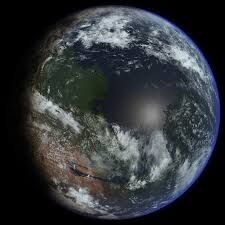Mars
Mars - once the dream of Mankind, and then the largest bastion of the Alliance for the Preservation of Democracy - is the seat of the modern Mankind's largest and most powerful authoritarian state. It has developed relatively recently (during the Transhuman Wars), yet has already made its mark on the Solar System.
Despite the damages and casualties that the planet suffered during the last century, Mars remains one of the industrial powerhouses of the Solar System, something seen as especially frightening considering the political radicalism of the Imperial Court. For many, Mars is a genocide waiting to happen. For others, its a crucial part of the Inner System stability and its defenses against the numerous threats filling the Outer System.
Geography
Three oceans - largest one to the north (reaching the pole, and hence, having rather cool water) and two endorheic near the equator (way warmer). The hydrosphere also includes a lot of lakes and rivers, typically taking advantage of what's left of the canals on the Mars surface (as a result, they requires next to no human intervention to form).
There is one large continent, composed of mostly alright to live north and the mountainous, mostly desert south. This means that despite Mars always being seen as the prime candidate for a terraformation, it's actually less pleasant for human habitation that the now-terraformed Venus.
Especially the poles are downright nasty, with the yearly average temperature shifting between around 15C during the summer solstice to -70 during the winter solstice. Due to the axial tilt, one can expect hot summers and cold winters to be a normal thing on Mars, to a rather tiring degree.
Ecosystem
Varied. You can find almost every biome somewhere on Mars, from rainforest to the arctic circle. As a result, Mars is a home to a very diverse ecosystem imported from Earth. It has to be mentioned that due to having one continuous landmass, you can see many unexpected mixtures of biomes living next to each other. This also forces the local settlers to ensure that no species turns invasive, as it could be potentially rather ruinous.
Natural Resources
Mars possesses a lot of natural resources, especially iron. In a way, it is like Earth, except that its resources weren't depleted by millenia of exploitation. Add a lot of rivers that can serve as a source of cheap energy, and you end up with Mars being a massive industrial powerhouse within the Solar System, and one that seems to be the least dependent on asteroid mining to maintain its production output.
History
Mars is counted among the oldest human colonies, with only Luna being older. It has remained the bastion of the Alliance for the Preservation of Democracy between the Third and Fourth World War, only to become de facto independent after its collapse.
Mars remained a prosperous (if conservative, and capitalist-leaning) republic until the Transhuman Wars. It was briefly occupied by the transhumans (both local and foreign), a process that was greatly aided by the fact that the planetary government has been thoroughly infiltrated by their sleeper agents before the war started.
The occupation didn't last for long, as the revolt happened. Transhumans were driven off-world, but to a surprise of most people, the leader of the revolt almost immediately installed himself as the authortiarian ruler of the planet. And, as if to drive the nail home, has also proclaimed himself an emperor a few years later.
Thus far he has succeeded in squashing every significant internal opposition. He is at least partially riding atop the wave of anti-transhumanism (caused by the drastic approach of the Transhuman Alliance to the local population), and the threat of further 'sleeper agents' hiding within the greater population. Whether he ends up being overthrowned remains to be seen.
Mars
Summary
Distance from Sun: 150.000 mil. km
Diameter: 4000 km
Solar Constant: 0.8
Mass: 0.09 Earths
Mean Density: 3 kg/l
Orbital period: 800 Earth days
Day length: 20 h 37 m
Rotation Axial Tilt: 15 degrees
Astrography
Type: Planet [Terraformed]
Location: Mars Subsystem
Satelites: Deimos, Phobos
Population: 324 mln
Governments
Empire of Mars
Summary
Distance from Sun: 150.000 mil. km
Diameter: 4000 km
Solar Constant: 0.8
Mass: 0.09 Earths
Mean Density: 3 kg/l
Orbital period: 800 Earth days
Day length: 20 h 37 m
Rotation Axial Tilt: 15 degrees
Astrography
Type: Planet [Terraformed]
Location: Mars Subsystem
Satelites: Deimos, Phobos
Population: 324 mln
Governments
Empire of Mars




Comments